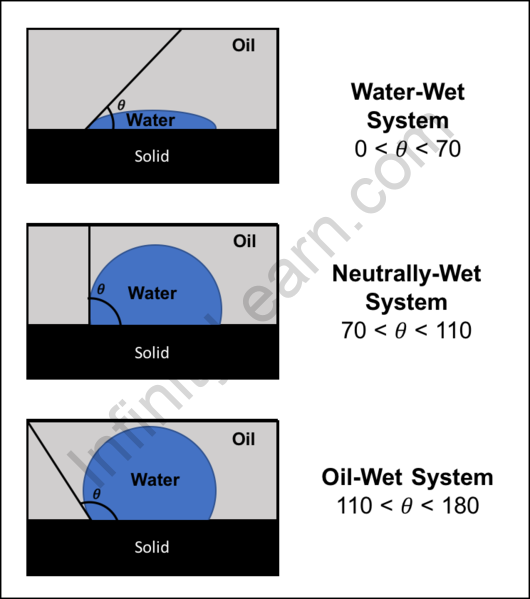Table of Contents
Introduction:
The angle of contact is defined as the angle subtended between the tangents drawn at the liquid surface and the solid surface inside the liquid at the point of contact, or it is outlined as the angle subtended among the tangents pulled at the liquid surface and the solid surface within the liquid at the contact point.
- The angle of contact is determined by the composition of the liquid, the solid in contact, and the medium above the liquid’s free surface.
- As the heating of the liquid rises, so does the angle of contact.
- When soluble contaminants are introduced to a liquid, the angle of contact diminishes.
A brief outline:
The importance of the contact angle:
The contact angle controls whether a fluid will spread or form droplets on a solid’s surface.
- When the contact angle is obtuse, a droplet would be created.
- When the contact angle is acute, the water would spread.
When liquid molecules come into contact with a solid (such as the wall of a capillary tube), the following forces apply to them: I
- Force of Cohesion Fc (acts at a 45° angle to the vertical)
- Adhesion Force Fa (acts outwards at a right angle to the wall of the tube)
The characteristics of the liquid and solid in contact and the medium above the liquid’s free surface determine the angle of contact. A glass capillary tube becomes water-proof when the wax is applied to it. The contact angle widens and becomes obtuse. It does not hold water. Rather, it falls into the tube because of the obtuse angle of contact.
- The liquid meniscus would be concave upwards if the angle is acute, i.e., 90°.
- The liquid meniscus would be plain if the angle is 90°.
- The liquid meniscus will be convex upwardly if it is obtuse, i.e., >90°.
- The liquid will moisten the solid surface if the angle of contact is acute, i.e., 90°.
- The liquid will not moisten the solid surface if the contact angle is obtuse, i.e., >90°.
Important concepts:
The angle of contact climbs as the temperature of the liquid rises. When soluble pollutants are introduced to a liquid, the angle of contact falls.
- For normal water and glass, the angle of contact is 0.
- It is 8° for normal water and glass.
- It’s 138° for mercury and glass.
- It is 90° for clean water and silver.
- 0° for alcohol and a clean glass.
Surface Tension:
In physics, surface tension is the tension of a liquid’s surface film caused by the attraction of surface particles by the bulk of the liquid, which strives to decrease surface area. Surface tension is used when the liquid’s surface is sufficiently strong. It can support a lot of weight.
Whenever water comes in contact with a hard surface in so many applications, in day-to-day activities such as painting a wall or using the medicine. Wettability is vital in the industry, for example, when making electronics or deciding how to extract oil from a reservoir. knowing the contact angle value in any of these applications provides a significant indication of the product’s or process’s performance.
The contact angle is a wettability metric.
When a drop of water is dropped on a solid, the forces between molecules among the solid and the liquid cause the drop to spread across the surface. The solid’s wettability is instantly determined by the water contact angle. The solid is said to have poor wetting and is called hydrophobic if the measured contact angle is greater than 90 degrees. The term hydrophilic is used when the contact angle is less than 90 degrees. Extreme occurrences of water spreading completely or forming a sphere on top of a solid are referred to as complete wetting and superhydrophobic surfaces, respectively.
Deposition or incorporation of various inorganic compounds onto the surface can often be used to control the wetting contact angle. This is frequently accomplished by employing specialized silane compounds capable of forming a SAM (self-assembled monolayers) layer. The contact angle of the surface can be tuned by using organic molecules with varied molecular structures and concentrations of hydrocarbon and/or per fluorinated terminations. These specific silanes can be deposited in the gas phase using specialized vacuum ovens or in the liquid phase using a liquid-phase method. Surface energy can be reduced by molecules that can attach more per fluorinated stops to the surface (high water contact angle).
The angle of contact controls whether a liquid will spread or form droplets on a solid’s surface. The angle of contact is the angle formed by a tangent to the liquid surface there at the point of contact and a solid surface within the liquid. It is denoted by the symbol. The liquid’s surface is bent near the plane of contact with some other medium. For different pairs of solids and liquids interfaces, the angle of contact varies. The value determines the angle of contact.

Frequently asked questions:
When a solid and a liquid have a 90o angle of contact, what happens?
When a solid and a liquid make a 90o angle of contact, it means they are in equilibrium. As a result, cohesive force equals adhesive force.
What happens to the contact angle as the temperature drops?
The angle of contact widens.
When the temperature rises, what occurs to the cohesive force?
The force of cohesion weakens.
When is a droplet going to form?
When the angle of contact is obtuse, a droplet forms.








